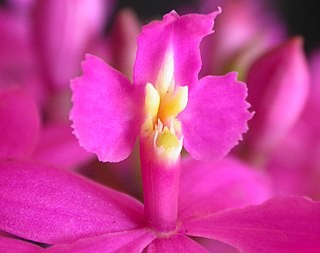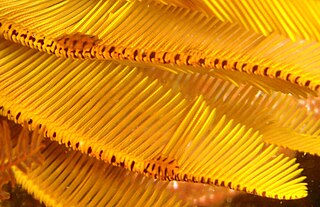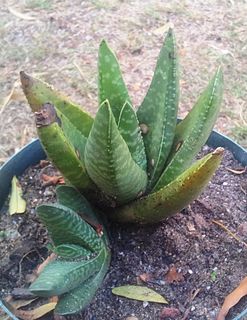
The Turks and Caicos rock iguana is a species of lizard endemic to the Turks and Caicos islands. This small iguana can reach 30 cm (12 in) and becomes mature at seven years and may live for twenty. A single clutch of up to nine eggs is laid each year, and these take three months to hatch. This iguana is mostly herbivorous, but supplements this by adding some animal matter to its diet.

Gasteria is a genus of succulent plants, native to South Africa.

Morelia carinata, commonly known as the rough-scaled python, is a large-scaled python species endemic to Australia. No subspecies are currently recognized.

Zephyranthes carinata, commonly known as the rosepink zephyr lily or pink rain lily, is a perennial flowering plant native to Mexico, Colombia and Central America. It is also widely cultivated as an ornamental and naturalized in the West Indies, Peru, Argentina, Brazil, the southeastern United States from Texas to Florida, Zimbabwe, South Africa, China, Korea, the Ryukyu Islands, Assam, Nepal, Bhutan, Sri Lanka, Solomon Islands, Queensland, Society Islands, Kiribati, and Caroline Islands.
Cyclura carinata bartschi, commonly known as Bartsch's iguana or the Booby Cay iguana, is a lizard of the genus Cyclura endemic to a single cay, Booby Cay, in The Bahamas.
Verticordia carinata, commonly known as pea-shaped featherflower or Stirling Range featherflower, is a flowering plant in the myrtle family, Myrtaceae and is endemic to Western Australia. It is an erect, spindly shrub with small, well-spaced leaves and pink and red flowers. It is a rarely seen plant, not known between its description in 1849 and its rediscovery in 1990.
Brassica carinata is a member of the genus Brassica. It is believed to be a hybrid between Brassica nigra and Brassica oleracea. Although Brassica carinata is cultivated as an oilseed crop in Ethiopia, it has high levels of undesirable glucosinolates and erucic acid. The closely related Brassica napus (Rapeseed) is considered a better oilseed crop in comparison.
Leptoxis carinata, common name the crested mudalia, is a species of freshwater snail with an operculum, an aquatic gastropod mollusk in the family Pleuroceridae.

Eria carinata is a species of orchid. It is native to Nepal, Bhutan, Assam, Thailand, Vietnam and peninsular Malaysia.

Epidendrum sect. SchistochilaRchb.f. (1861) is a section of the subgenus E. subg. AmphiglottiumLindl. (1841) of the Genus Epidendrum of the Orchidaceae. E. sect. Schistochila differs from the section E. sect. Holochila in that the species in E. sect. Holochila have undivided lips; the species in E. sect. Schistochila have lobate lips. The species in both E. sect. Schistochila and E. sect. Holochila have racemose inflorescences, unlike those in E. sect. Polycladia, which have truly paniculate inflorescences. Like the other sections of E. subg. Amphiglottium, the members of E. sect. Schistochila are sympodial orchids bearing thin stems with alternate leaves, a long peduncle covered with thin, imbricating sheathes, and a lip adnate to the very end of the column.

Candoia carinata, known commonly as the Pacific ground boa or the Pacific keel-scaled boa, is a species of snake in the family Boidae.

The elegant feather star is a species of crinoid in the family Tropiometridae.

Nudol is a phenanthrenoid of the orchids Eulophia nuda, Eria carinata, Eria stricta and Maxillaria densa.

Commonly known as the keeled rat snake, Ptyas carinata is a species of colubrid snake. It is found in Indonesia, Myanmar, Malaysia, Thailand, Philippines, Cambodia, Vietnam and Singapore. This little known species is probably the largest extant species in the diverse colubrid family that comprised just over half of living snake species. Known adult lengths of snakes of this species in Taiwan measured anywhere from 1.21 to 2.75 m. However, the maximum reportedly size was about 4 m. Males reportedly average slightly larger than females. They are probably opportunistic predators on a variety of prey, such as rodents, though adult lizards are thought to be significant prey in Indonesia.

Sybra is a genus of beetles in the family Cerambycidae, containing the following species:

Gasteria carinata is a small and variable succulent plant, native to the Western Cape Province, South Africa.

Sybra umbratica is a species of beetle in the family Cerambycidae. It was described by Pascoe in 1865.

Sybra ordinata is a species of beetle in the family Cerambycidae. It was described by Bates in 1873.
Sybra pascoei is a species of beetle in the family Cerambycidae. It was described by Lameere in 1893.

Liza carinata, the keeled mullet, is a species of grey mullet from the family Mugilidae which is found in the western Indian Ocean and eastern Mediterraean Sea. It colonised the Mediterranean by Lessepsian migration from the Red Sea through the Suez Canal. The keeled mullet is a species of minor importance in commercial fisheries.
















